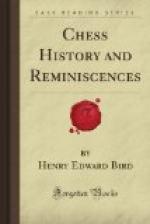Sir F. Madden, 1828, remarks: “It is sufficient, at present, to assume on the authorities produced by the learned Dr. Hyde and Sir William Jones that for the invention and earliest form of this game we must look to India, from whence through the medium of the Persians and the Arabs, as proved demonstratively by the names of the chessmen it was afterwards transmitted to the nations of Europe.”
It seems that we may be satisfied that chess is of Asiatic origin, and India its birth place without subscribing entirely to the view that even the ancient Hindu Chaturanga so minutely described and which comes so long before any other game mentioned in China or Egypt is even the first of chess; but we may say this much, that, notwithstanding, the doubts expressed by Crawford in his history and Rajah Brooke in his journal, and the negative opposition of Dr. Van der Linde, we cannot bring ourselves to be skeptical enough to discredit the trustworthiness of the accounts furnished to us in the works of Dr. Hyde, Sir. William Jones and Professor Duncan Forbes of the existence of the game called the Chaturanga at the time stated.
Note. The Amara Kosha was one of the most valued works of Amara Sinha one of the nine gems which adorned the throne of Vikramaditya. The period, when he lived, was that from which the Hindoos date their present chronology; that is he lived about the middle of the first century B.C. The Amara Kosha was one of his numerous works preserved, if not the only one that escaped. They perished, it is said, like all other Buddhistical writings at the time of the persecutions raised by the Brahmans against those who professed the religion of Buddha.
------
Sanskrit scholars, including Colebrooke and Captain Cox, writing rather incidentally than as chess players, inform us that the pieces used in our game, viz. the Rook, Knight, and Bishop are referred to in old Indian treatises, under their respective names of Elephant, Horse, and Ship, which is a most convincing item of evidence to chess players. This is one of the three main things which historians fail to notice; the Roman Edict of 115 B.C. and 790 to 793 A.D., the least unlikely period for English acquirement of the game, on Alcuin’s three years visit from Charlemagne’s court, being the two others most meriting attention and noticed in their respective places.
Note. The Roman Edict of 115 B.C. exempting chess and Draughts from prohibition, when other games were being interdicted, seems to have escaped the notice of all writers, and does not harmonize with the Germans Weber and Van der Linde’s theories of 954 A.D. for the earliest knowledge of chess in its precise form.
Note. Alcuin, 735-804, is a name forgotten by all writers in considering the Charlemagne, Koran, and Princess Irene period and English probabilities.
Note. The Sanskrit translations for the glorious Al Mamun, 813 to 833, those mentioned in the Sikust (980), and for the enlightened Akbar, 1556 to 1615, seem to have been unknown to European scholars, who throughout the early and middle ages do not strike us as having been remarkable for zeal and application.




